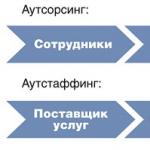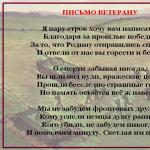Flora and fauna presentation. Presentation on the topic: Flora and fauna of Russia. Last presentation slide: Flora and fauna of Russia
Description of the presentation by individual slides:
1 slide
Slide description:
Adaptations of animals in the desert They have a general grayish-yellow or brown color to match the color of the sands. They can for a long time do without water and food, some do not drink at all (moisture from plants is enough for them). Some during the day, in the heat, sleep in burrows and are active at night. Nests are made mainly in the ground, and not on its surface, and they run quickly. Some animals have large ears pierced by a network of tiny blood vessels, and the wind blowing on these ears cools the blood washing them. Long-eared hedgehog Yellow gopher
2 slide
Slide description:
Expand and deepen the understanding of the general features of the flora and fauna of Russia Consider the types of natural zones in Russia, patterns of distribution of representatives of flora and fauna on the territory of Russia, Identify features of adaptation to the environment Goal of the lesson
3 slide
Slide description:
History of the formation of the territory Natural conditions: differences in light conditions, temperature, humidity, soil nature, relief) Economic activity person Clicking on the book icon opens two tooltips
4 slide
Slide description:
1. History of the formation of the territory Both plants and animals carry in their appearance and distribution features inherited from the distant past. Desert-steppe groups of plants and animals came to us from Central Asia. North American conifers penetrated from Alaska to the Far East. Specific Features Our Far Eastern flora is combined with the originality of the Manchu-Chinese fauna. The flora and fauna of Russia were greatly influenced by the Quaternary glaciation. Manchurian walnut
5 slide
Slide description:
Plants and animals are perfectly adapted to natural conditions your locality. Trees in forests, grasses in the steppes, dwarf and crooked forests in the tundra - all these are examples of the ideal adaptation of plants to their environment. Vary according to appearance and the adaptation of animals to the same conditions - flying, running, climbing, swimming. In the distribution of representatives of certain species of plants and animals, patterns can be traced that are determined by latitudinal zonality and altitudinal zonation. 2. Natural conditions
6 slide
Slide description:
Why do natural zones in Russia change from north to south? Using a map, list the natural zones of our country. What adaptations of plants and animals do you know? What is this connected with?
Slide 7
Slide description:
On the territory of Russia there is a change from north to south of the following natural zones: arctic deserts, tundra, forest-tundra, taiga, mixed and broad-leaved forests, forest-steppes, steppes, semi-deserts, subtropical forests
8 slide
Slide description:
Organic world of Russia Plants Animals 18,000 species 130,000 species of which up to 90,000 species of insects 1450 710 350 160 Classes of vertebrates fish birds mammals amphibians 13500 500 grass trees
Slide 9
Slide description:
Indeed, animals are also located in the closest unity with plant communities: mammals, birds, reptiles, insects. Each species of animal, as well as plants, adapts to certain living conditions. Animals find sources of existence in the Arctic desert, in the tundra, in the sands, on the plains, and in the mountains.
10 slide
Slide description:
Arctic desert The Arctic is called silent, dull, harsh, but they also say that it is hospitable and enchantingly beautiful. But its beauty can only be seen by those who understand and know a lot about the Russian north.
11 slide
Slide description:
Flora of Arctic deserts Few living organisms have adapted to the harsh conditions of Arctic deserts. Vegetation on a surface free of ice and snow does not form a closed cover. These are cold deserts. Mosses and lichens dominate among the plants. It is extremely rare, but some types of flowering plants are found: polar poppy, buttercup, saxifrage. Kukushkin flax Polar poppy Saxifraga Lichen
12 slide
Slide description:
Adaptations of plants in the Arctic Grow in places protected from the wind Low-growing, often creeping along the surface Cushion-shaped plants (allows them to be warmed by the sun's rays) Using 24-hour summer lighting, they manage to germinate from a seed, bloom and form seeds in a short time
Slide 13
Slide description:
Fauna of the Arctic deserts The fauna is also sparse. Those that are fed by the sea predominate: walruses, seals, polar bears, etc. Noisy bird colonies are located on the rocky shores in the summer. Walrus Seal Bird market Polar bear
14 slide
Slide description:
Adaptations of animals in the Arctic White coloring Food only in the sea, so they all swim well On land there are no plants, so animals are mainly predators Protection from the cold - thick fur, thick skin and a layer of fat; birds have loose plumage Birds are migratory, only in the spring do bird colonies come to life, when the ice moves away from the shore White seal White owl
15 slide
Slide description:
Tundra Tundra is the kingdom of cold, snow, piercing wind, permafrost, blizzards and blizzards.
16 slide
Slide description:
Vegetation of the tundra The first thing that catches your eye in the tundra is the absence of the trees we are accustomed to. An endless plain stretches from horizon to horizon. Mosses, lichens and shrubs predominate. All plants prefer to huddle close to the ground, hide behind each other, to escape the freezing wind. Even the trees - dwarf birch and willow - hardly rise above the grass. There are no annual plants - summer is too short for them. Typical representatives of the tundra are: moss lichen, green mosses, lingonberry, crowberry, partridge grass, cassiopeia, arctic bluegrass, etc. Cassiopeia Lingonberry Crowberry Partridge grass
Slide 17
Slide description:
Adaptations of plants in the tundra Perennial plants Low-growing, creeping along the ground Small leaves are often curled, covered with hair, have a waxy coating Roots are located close to the surface Many plants in bloom tolerate frost Brightly colored flowers attract insects Dwarf birch
18 slide
Slide description:
Fauna of the tundra The fauna is poor in the number of species. Only a few of them have adapted to living in harsh winter conditions and do not leave the tundra all year round. These are lemmings, hare, wolf, white partridge, polar owl. One of the most common animals is Arctic foxes. In winter, they roam along rivers and sea coasts, and some go into the ice of the Arctic Ocean. Arctic foxes are predators. Their main food is lemmings. Ptarmigan Reindeer Arctic fox Lemming
Slide 19
Slide description:
Adaptations of animals in the tundra Light-colored fur in animals and plumage in birds Accumulation of a layer of subcutaneous fat Thick fur in animals, warm down in birds Insulation of limbs for the winter: warm insoles in arctic foxes, pubescent paws in birds Hibernation Seasonal migrations Equipment for shoveling snow Reindeer - wide hooves, wandering in search of pastures Hare - white hare
20 slide
Slide description:
The forest zone occupies more than half of the territory of Russia. Russian forests are diverse in species composition and number of tree species. Here you can find gloomy dark coniferous taiga, bright sunny pine forests, majestic oak forests, white-trunked birch forests, unique mixed forests, and tall larch taiga. Forest zone
21 slides
Slide description:
Taiga The word “taiga” from the language of many northern peoples means mountains covered with forests. By taiga we mean a special kind of forest, namely coniferous. Taiga occupies about 80% of the forest area of Russia. It can consist of spruce, fir, pine, cedar, larch.
22 slide
Slide description:
Coniferous forests vary widely as you move away from the ocean. The taiga vegetation of Russia is represented by dark coniferous forests of spruce and fir in the north, taiga cedar and larch forests in Siberia Flora of the taiga Spruce Cedar Pine
Slide 23
Slide description:
Adaptations of plants in the taiga Taiga forests are usually formed by one layer of trees (since there is little light), under which there is a moss cover with lingonberry and blueberry bushes and rare herbs. Almost all conifers are evergreen and, thanks to their needles, can produce food all year round. The powerful roots of the leaves are turned into needles with a waxy skin, which prevents the needles from drying out. Some conifers (larch) have adapted to shed their needles for the winter. Larch
24 slide
Slide description:
Fauna of the taiga The most common mammals in the taiga are: elk, musk deer, squirrel, flying squirrel, chipmunk, mountain hare, brown bear, lynx, weasel, ermine, weasel. Typical taiga birds are wood grouse, Ural owl, hawk owl, great owl, three-toed woodpecker, cuckoo, nutcracker, bullfinch, white-winged crossbill and crossbill. There are also reptiles in the taiga - the common viper and viviparous lizard, and among amphibians only one four-toed newt is widespread. Lynx Weasel Tawny Owl
25 slide
Slide description:
Adaptations of animals in the taiga Store food for the winter Many animals grow thicker fur in winter and develop protective coloring. Some animals make temporary homes in the snow. The mountain hare, lynx and wolverine have wide paws. The capercaillie and hazel grouse have toes lined with a horn-like fringe (it grows and helps birds stay on icy tree branches.) Bears and chipmunks hibernate for the winter and live off fat reserves. A peculiar structure of the beak (crossbill) Chipmunk Crossbill
26 slide
Slide description:
Broad-leaved forest Broad-leaved forests grow in conditions of mild winters and long summers. These are the most species-rich forests. Since broad-leaved forests are very demanding on climatic conditions, they grow only in the European part of Russia.
Slide 27
Slide description:
Flora of a broad-leaved forest In a deciduous forest, five tiers or more can be distinguished. The upper, first tier is formed by tall trees - oak, linden, birch, elm. In the second tier there are trees of the second size - mountain ash, bird cherry, willow, wild apple tree. The third tier of the forest consists of shrubs that form the undergrowth - common hazel, honeysuckle, buckthorn, and euonymus. The fourth tier of the forest consists of tall grasses - chistets, boron, and wrestlers. The fifth tier of the forest is represented by lower grasses - sedge, sedge, and others. The sixth tier is mosses, mushrooms, lichens. Bird cherry Elm Linden
28 slide
Slide description:
Adaptations of plants in a broad-leaved forest In a deciduous forest, five or more tiers can be distinguished. An adaptation of deciduous trees to the change of seasons is leaf fall.
Slide 29
Slide description:
Fauna of deciduous forests The most common animals in deciduous forests are: lynx, forest cat, brown bear, marten, polecat, mink, weasel, squirrel, several species of dormouse. Birds that are especially numerous here are: woodpeckers, pigeons, orioles, chaffinches, wood larks, tits, blackbirds, songbirds, nightingales, and robin. Often found in deciduous forests are green and viviparous lizards, spindles, copperheads and common vipers, and among amphibians - grass and sharp-faced frogs and tree frogs. Oriole Spindle Mink Brown bear
30 slide
Slide description:
Adaptations of animals in deciduous forests Forests are characterized by a tiered distribution of animals. Relatively high density of terrestrial animals (deer, wild boars, etc.), many birds. The predominant birds here are insectivores and granivores. They hide in nests, hollows and holes. During the winter, cold-blooded animals (insects, amphibians, reptiles) fall into a state of suspended animation (life processes are slowed down). Of the birds and mammals, some migrate to warmer regions, others hibernate, and only a few are active all year round. Squirrel Ferret
31 slides
Slide description:
32 slide
Slide description:
Flora of the steppes There are no trees in the steppe because they lack moisture. Typical steppe plants are turf grasses with narrow leaves: feather grass, fescue, tonkonogo. Along with them, forbs are always present in steppe communities. Iris Tipchak Thinlegs
Slide 33
Slide description:
Adaptations of plants in the steppe. Annuals predominate. Some of them - tulips, irises - bloom in the spring, before the summer heat sets in and there is enough moisture in the soil. Many cereals form a powerful root system that absorbs melt and rain water and retains it for a long time. They tolerate severe drought thanks to very narrow leaves that evaporate little moisture. Many plants use pubescence to protect themselves from sunlight. Feather grass Tulip
Scenario for a geography lesson on the topic “Flora and fauna of Russia”
Author: Galina Vladimirovna Krasikova, geography teacher, MBOU “Bellykskaya Secondary School”, Krasnoturansky district, Krasnoyarsk TerritoryLesson type: a lesson in discovering new knowledge.
The purpose of the lesson: create conditions for the formation of ideas about the causes of diversity, features and patterns of distribution of the flora and fauna of the country.
Planned personal results: awareness of the integrity of Russian nature, its geographical space as a single habitat for living organisms
Planned meta-subject results: set a cognitive task under the guidance of a teacher; use text and cartographic sources of information; extract the necessary information from the text and translate it into symbolic, tabular form and vice versa; establish cause-and-effect relationships; are active in interaction to solve communicative and cognitive problems, plan their activities under the guidance of a teacher and independently; work in accordance with the assigned task; compare the results obtained with the expected ones
Planned subject results: Students will learn to: explain the reasons for the species diversity of flora and fauna; name the main types of vegetation in Russia, describe their characteristic features; explain the dependence of the characteristics of the flora and fauna of a natural community on its geographical location on the territory of Russia, give examples; Students will have the opportunity to learn: identify the features of adaptation of living organisms to the climatic conditions of the territory
During the classes
Stage 1. Motivation to educational activitiesTeacher activities: welcomes students, checks their readiness for the lesson. Invites you to pay attention to the board Slide 1
- Here are photographs of paintings by great Russian artists. Remember their names and authors.
Opens titles and authors on slide 1
- What do you think inspired the artists to create these works of art?
- Why did I start the lesson with these paintings?
Corrects the wording of the topic, opens slide 2, and suggests writing the topic down in notebooks.
Student activities: look at the photo, express their assumptions. Formulate the topic of the lesson. Write down the topic in your notebooks.
Stage 2. Updating knowledge and recording individual difficulties in a trial learning activity
Teacher activities: demonstrates slide 3 and offers to complete the task: insert the missing words into the text:
The following natural zones are located on the territory of Russia: arctic deserts, ______________, mixed and deciduous forests, taiga, ________, deserts and semi-deserts. The largest natural area in our country is ____. Characteristic feature Tundra vegetation is_____. Of the large ungulates in the steppes, the most common are ____.
Student activities: perform the task individually (in pencil), identify difficulties, formulate the problem.
Stage 3. Construction of a project for getting out of difficulties. Setting a learning task
Teacher activities: organizes a conversation on the following questions: - What needs to be done in class to solve the identified problem? - What tasks will we set for ourselves today? - What skills will we need to complete the assigned tasks?
Student activities: Suggest ways to solve a problem. Formulate the goals and objectives of the lesson. They call it skills.
Stage 4. Implementation of the completed project
Teacher activities: organizes a conversation on the following questions: - Do you think the plant cover and composition of the animal world are the same throughout the entire territory of our country? And why? What does this depend on? - Think about what continents and countries is the flora and fauna of Russia similar to? Why? - What do you think influences character more? natural complex Are the territories plants or animals?
Offers to complete test tasks(slide 4), working with the map in groups. Sources of information: textbook maps pp. 108,110, maps of the Atlas “Vegetation”, “Natural zones and their inhabitants”.
Organizes a discussion and self-test of the standard test (slide 5).
Student activities: answer the questions posed, reason, establish cause-and-effect relationships, compare the features of the nature of Russia with other territories.
They work in groups with a map and perform test tasks.
Take part in the discussion, perform self-tests against the standard, and fill out assessment sheets.
Take part in the discussion and, together with the teacher, determine a list of characteristics.
Teacher activities: proposes to consider the features of the flora and fauna of each of the natural zones: arctic deserts and tundra; taiga, mixed and deciduous forests; steppes; semi-deserts and deserts. Organizes a discussion about what characteristics need to be reflected.
Summarizing the discussion, slide 6 shows.
Offers sources of information: textbook pp. 107-111, maps of the Atlas “Vegetation”, “Natural zones and their inhabitants”. The result of the activity must be presented in the form of a logical reference summary or mind maps.
Student activities: choose an object of study, use Appendix No. 2 to remember the requirements for reference notes and mind maps, decide on the form of the product, work in a group.
Stage 5. Primary consolidation with pronunciation in external speech
Teacher activities: organizes the presentation and discussion of the resulting products. If necessary, clarifies and supplements the information provided. As the groups perform, they offer to fill out the table (slide 7). Characteristics of natural zones of Russia. The first line is filled in frontally, the rest - independently.
Organizes assessment of the performance of groups and each student.
Student activities: characterize natural areas using a logical reference outline or mind map.
Fill out the table in your notebooks. Ask clarifying questions.
Together with the teacher, they evaluate the groups in accordance with the requirements of Appendix 2. Discussing in the group, they assign points to each student on the assessment sheets based on the mark given to the group.
Stage 6. Inclusion in the knowledge system and repetition
Teacher's activities: organizes discussion and mutual verification of filling out the table. Demonstrates the criteria (slide 8) for cross-checking the table.
Suggests returning to texts (Appendix No. 2), working with which caused difficulties at the beginning of the lesson. Organizes individual work for students and self-tests.
Invites groups to exchange assessment sheets, calculate the number of points scored by each and set a final mark using the criteria (slide 10).
Student activities: exchange notebooks within the group, check and evaluate the table according to the criteria. They put points on the assessment sheets.
Complete the task (by hand) and perform a self-test against the standard. Fill out assessment sheets. They exchange sheets, calculate the number of points and give a final mark.
Stage 7. Reflection on learning activities in the lesson
Teacher activities: opens slide 11, organizes reflection using a cloud of “tags” that need to be supplemented orally.
Student activities reflect on their activities.
Stage 8. Homework
Teacher asks d/z: study paragraph 20, compose a syncwine or crossword puzzle (at least 7 words) on the topic of the lesson of your choice. Students write down d/z.
Presentation on the topic: Flora and fauna of Russia
https://accounts.google.com
Slide captions:
Flora and fauna of Russia.
Goals and objectives of the lesson: get acquainted with the diversity of flora and fauna of Russia; continue to develop the ability to analyze thematic maps.
In Russia there are about 18 thousand species of plants (of which about 500 species of trees) and approximately 130 thousand species of animals (of which about 90 thousand are insects). How can this diversity be explained? Firstly, physical and geographical differences between regions (temperature, precipitation, humidity, soil, terrain features). Secondly, the geological history of the territory’s development.
Main types of vegetation in Russia. 1) vegetation of arctic deserts, 2) tundra vegetation, 3) forest vegetation (taiga, mixed and broad-leaved forests), 4) steppe vegetation, 5) semi-desert and desert vegetation.
Describe one of the types of vegetation according to the plan: 1) In what natural zone is it located? 2) What climatic conditions are typical for it. 3) What soils dominate. 4) How plants adapt to natural conditions. 5) Typical plants.
Vegetation of Arctic deserts. lichens novosiversiya icy (arctic rose)
Preview:
To use presentation previews, create a Google account and log in to it: https://accounts.google.com
Slide captions:
Tundra vegetation. moss lingonberry polar willow
Forest vegetation (taiga, mixed and broad-leaved forests). spruce fir aspen birch
Steppe vegetation. feather grass fescue thin-legged
Preview:
To use presentation previews, create a Google account and log in to it: https://accounts.google.com
Slide captions:
Vegetation of deserts and semi-deserts. wormwood solyanka
Using Fig. 54 on page 141, textbook text and presentation, fill out the table. Fauna of Russia. Natural zone Typical animals Food supply and adaptations of animals to living conditions Arctic desert Tundra Forests Steppes Deserts and semi-deserts
Fauna of Russia. Arctic desert. walrus polar bear seal bird colonies
Fauna of Russia. Tundra. Lemming Snowy hare Snowy owl Arctic fox Ptarmigan Reindeer
Slide 1
 Slide 2
Slide 2
 Slide 3
Slide 3
 Slide 4
Slide 4
 Slide 5
Slide 5
 Slide 6
Slide 6
 Slide 7
Slide 7
 Slide 8
Slide 8
 Slide 9
Slide 9
 Slide 10
Slide 10
 Slide 11
Slide 11
 Slide 12
Slide 12
 Slide 13
Slide 13
 Slide 14
Slide 14
 Slide 15
Slide 15
 Slide 16
Slide 16
 Slide 17
Slide 17
 Slide 18
Slide 18
 Slide 19
Slide 19
The presentation on the topic “Flora and fauna of Russia” (8th grade) can be downloaded absolutely free on our website. Project subject: Geography. Colorful slides and illustrations will help you engage your classmates or audience. To view the content, use the player, or if you want to download the report, click on the corresponding text under the player. The presentation contains 19 slide(s).
Presentation slides

Slide 1
Presentation of the topic “Flora and fauna of Russia.” Geography. 8th grade

Slide 2
Flora and fauna. Biological resources. Protection of flora and fauna. Natural resource potential of Russia.
Flora and fauna.

Slide 3
HOW ARE PLANTS DIFFERENT FROM ANIMALS? At first glance, answering this question is not at all difficult. Any animal is significantly different from, for example, a tree. However, they also have a lot in common. It is often said that plants, unlike animals, do not move. It turns out that plants also make movements, only more slowly. In addition, there are sessile marine animals that move as slowly as plants. It is believed that plants are not capable of feeling. For example, they do not respond to touch. This is also not true. Mimosa leaves fold quickly when touched with a finger, and the pods of some plants shoot seeds in response to a push. Not all plants have leaves and stems. On the other hand, there are insects whose shape resembles a dry stick or leaf.

Slide 5
Features of flora and fauna
Natural zone Adaptations to living conditions Typical representatives Protection of biological resources

Slide 6
Along the coasts of the Arctic Ocean there is a wide strip of tundra - an area without forests with swamps, rivers and streams. The climate here is so harsh that tall trees cannot grow. The long frosty winter, lasting 9 months a year, gives way to short and cool summers. Due to low temperatures, the ground freezes; in the summer, only the top layer of soil has time to thaw, on which mosses, lichens, grasses, small shrubs - blueberries, cloudberries, lingonberries, as well as creeping dwarf willow and dwarf birch grow. Plants have adapted to such a harsh climate: as soon as summer comes, they begin to hastily bloom in order to produce fruits and seeds before the onset of cold weather. Ripe seeds survive the long winter without freezing.

Slide 7

Slide 8
Taiga is dense coniferous forests. They grow in the northern regions of Eurasia and North America, where there are harsh snowy winters and short summers. Taiga is famous for its spruce, pine, fir, cedar, larch - trees that have narrow and dense needles instead of leaves. Only these are also leaves that are not afraid of strong winds, and their dense leathery surface reliably protects from frost. But not only do they grow in the taiga coniferous trees, it is full of mushrooms and berries - blueberries, blueberries, cloudberries, lingonberries, blackberries, raspberries, and the taiga “floor” is lined with bright green velvety moss. Taiga animals have managed to adapt well to long periods of cold and severe frosts. To survive the harsh winter, the brown bear and some rodents hibernate. And animals such as elk and reindeer, which have extraordinary endurance, are capable of covering long distances in the most severe cold and finding food under the snow. Their wide hooves allow them to avoid falling into deep snow and move with less effort.
Predators - lynx, wolf, fox - are also excellent stayers; they can cover tens of kilometers in search of prey.

Slide 9
MIXED FORESTS
Mixed forests grow in temperate regions. Here the winters are not too cold and the summers are warm. Precipitation occurs throughout the year. Since the climate here is milder than in the taiga, in the mixed forest there are not only coniferous trees (pine, spruce), but also deciduous trees (birch, aspen, alder). The further south you go, the warmer the winter, and the mixed forest gradually turns into deciduous. Oak, beech, maple, and ash are completely replacing conifers. In autumn, fallen leaves of trees form a dense carpet on the ground, which gradually rots. Therefore, in the mixed forest zone the soil is more fertile than in the taiga. Mixed and deciduous forests consist of three tiers. Above are tree crowns, below are shrubs (raspberry, elderberry, rowan, hazel), below are a variety of herbs, berries, mushrooms, ferns, horsetails, and mosses. Mixed forests are a haven for a wide variety of animals: bears, wolves, foxes, hares, hedgehogs, squirrels, wild boars, moose, and field mice. The only problem is that the zones of mixed and deciduous forests have long been developed and are very densely populated by people, so many of the inhabitants of these forests today can more often be seen in a zoo than in a forest. True, for last years Many nature reserves and national parks have been created where all these animals thrive.

Slide 10
Who am I and in what tier of the forest do I live?
A characteristic feature of this order is small, identical teeth. These are the teeth that the most ancient ancestors of all viviparous mammals had. Small awl-shaped teeth are convenient for grabbing worms, snacking on larvae, and crushing the shells of beetles and snails. The prey of insectivorous mammals has remained virtually unchanged for millions of years. It is not surprising that their teeth remained the same - small and identical.

Slide 11
To the south of the zone of mixed and deciduous forests, steppes begin - huge, flat spaces overgrown with tall grasses. There are no trees in the steppe because they lack moisture. The climate in the steppes is quite warm: hot, dry summers with rare rains and moderately cold, wet winters. Many plants begin to bloom in early spring, as soon as the snow melts, while it is not too hot and there is enough moisture in the soil.

Slide 12
In the steppe it is very fertile soils- chernozems, so today almost all steppe territories have been turned into arable land, where people grow many crops. The natural nature of the steppe has been preserved only in nature reserves. Ungulates are also found in the steppe - antelopes and saigas. And in the steppes there lives an unusual bird, the bustard, which prefers long-distance running to flight.


Slide 14
Adaptation of animals of the steppes
The steppe has a fairly rich fauna. Among the steppe animals there are many rodents that dig deep holes, where the animals escape the summer heat and winter cold. These are gophers, hamsters, marmots, mole rats.

Slide 15
Azonal plant communities do not form a continuous strip: meadows and swamps. Of course, returning the world to primitiveness is neither possible nor necessary. But a person must take into account the consequences of any of his actions. If you want to drain the swamp, check if it feeds the sources of the river. If you want to produce products, calculate how much waste there will be and how to get rid of it. A person should not live by the values of one day - to predatorily cut down a forest, sell it and live with this money where the grass is still green. Therefore, most countries in the world have adopted environmental protection laws.
Flora and fauna of Russia Flora of Russia
- The flora of Russia is one of the most important components of nature, which is represented by a collection of various plant communities growing on the territory of Russia. The wide variety of climatic conditions and soil cover, as well as the influence of past geological eras and increasing human activity, causes the existence of many types of vegetation that have complex combinations with each other.
- The following types of vegetation are most typical for Russia: tundra, forest, steppe, desert, meadow and swamp.
- Forests occupy 45% of the country's territory.
- Coniferous forests occupy about 80% of the forest area of Russia. They are divided into dark coniferous (spruce, fir, cedar) and light coniferous (pine, larch).
- Broad-leaved forests are common on the East European Plain, in the southern part Far East, in the lower parts of the Caucasus Mountains.
- In the steppes there grow communities of herbaceous plants that tolerate a lack of moisture in the soil well. These are mainly feather grass, fescue, thin legumes, legumes, and there are many meadow plants.
- Human economic activity has greatly changed the natural vegetation cover of the steppes.
- In Russia, deserts are common only in the Caspian lowland. Plants in this zone are characterized by greater drought resistance, they have a powerful root system and a small leaf surface area. Mainly different kinds wormwood and solyanka.
- Meadows contain communities of herbaceous plants that develop under average moisture conditions. Almost all meadow plants are perennials.
- Communities of moisture-loving plants grow in swamps. This type includes mosses, shrubs, herbaceous plants and even some types of trees. Most of Russia's swamps are located in Western Siberia.
- Tundra plants are formed when there is a lack of heat, so they are adapted to a short, cool growing season, are perennials, have dwarf growth, and tend to reduce moisture evaporation (they have small leaves, strong pubescence, a waxy coating, etc.). Typical representatives of the tundra: green mosses, moss, lingonberry, crowberry, partridge grass, cassiopeia, dwarf birch, polar willows, polar poppy, arctic bluegrass and others.
- The tundra zone covers about 10% of the territory of Russia. In addition to deer (used by the local population in farming), typical inhabitants of the tundra are arctic fox, musk ox, lemming, White Owl, partridge, loon.
- The fauna of the Tundra is poor in the number of species. Only a few of them have adapted to living in harsh winter conditions and do not leave the tundra all year round. These are lemmings, white hare, arctic fox, wolf, white partridge, polar owl. In winter, reindeer migrate from the tundra to the forest-tundra, where the winds are not so strong, so the snow is less dense and it is easier to get moss from under it.
- Taiga is the most extensive natural zone in Russia, accounting for over 60% of Russia's area. Fur-bearing animals are widespread within the taiga - sable, squirrel, marten, ermine, chipmunk; inhabited by elk, brown bear, wolverine, wolf, muskrat, lynx.
- Characteristic species include roe deer, wolf, marten, fox and squirrel. The fauna of the Far Eastern mixed forests is rich and unique - the Amur tiger lives here, dappled deer, raccoon dog, Manchurian hare, Far Eastern forest cat, pheasant, mandarin duck, etc.; insects are very diverse.
- The length of the steppe from north to south is European Russia- about 20,000 km. Representatives of the steppe fauna are distinguished by their adaptability to arid climates; Characterized by various species of rodents (marmot, gopher, etc.), steppe wolf, fox and antelope (in the south), manula (in the steppes and forest-steppes of Siberia), steppe viper, saiga. The most common birds are the steppe eagle, kestrel, lark, gray partridge; Bustards, once typical of the steppe, are quite rare.
- These natural zones occupy a small part of the territory of Russia and are located within the Caspian lowland. The fauna here is adapted to the dry continental climate. The jerboa, corsac fox, pelican, turtle, and long-eared hedgehog live here; Various snakes and lizards. Among the birds there is a lark.





